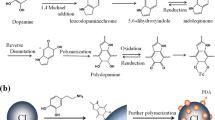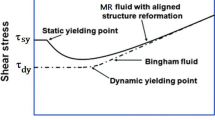Abstract
In this study, conductive polyindole (PIn) was coated onto initially fabricated magnetic iron oxide (Fe3O4) particles via chemical oxidative polymerization, and the synthesized core–shell structured hybrid smart particles were used as smart electrorheological/magnetorheological (EMR) materials. The synthesized Fe3O4/PIn particles were characterized using scanning electron microscopy and transmission electron microscopy. In addition, the chemical composition of the synthesized particles was confirmed using Fourier-transform infrared spectroscopy. Their magnetic properties were further analyzed using VSM. Consequently, the Fe3O4/PIn particle-based suspension, which was both magnetic and conductive, was found to exhibit interesting dual stimuli under both external electric and magnetic fields. Various rheological measurements, including shear simple steady shear and dynamic tests, were employed to evaluate the behavior of typical EMR suspensions. Furthermore, the dielectric properties of the particles were analyzed using an LCR meter. Based on the dielectric spectrum data, the relaxation time (λ) was estimated to be 1.5 × 10–8 s at the maximum frequency (λ = 1/2πfmax). Measurements conducted using a Turbiscan indicated enhanced sedimentation stability of the particles owing to a decrease in the particle density from 4.34 to 2.93 g/cm3.












Similar content being viewed by others
Data availability
Data will be made available on request.
References
Hoseinzadeh M, Rezaeepazhand J (2014) Vibration suppression of composite plates using smart electrorheological dampers. Int J Mech Sci 84:31–40
Son KJ (2017) A nonlinear rheological model for the ultrasonically induced squeeze film effect in variable friction haptic displays. Korea-Austral Rheol J 29:219–228
Li CL, Chen JK, Fan SK, Ko FH, Chang FC (2012) Electrorheological operation of low- /high-permittivity core/shell SiO2/Au nanoparticle microspheres for display media. ACS Appl Mater Interf 4:5650–5661
Lee S, Noh J, Jekal S, Kim J, Oh WC, Sim HS, Choi HJ, Yi H, Yoon CM (2022) Hollow TiO2 nanoparticles capped with polarizability-tunable conducting polymers for improved electrorheological activity. Nanomater 12:3521
Marins JA, Soares BG, Silva AA, Hurtado MG, Livi S (2013) Electrorheological and dielectric behavior of new ionic liquid/silica systems. J Colloid Interf Sci 405:64–70
Sedlacik M, Mrlik M, Kozakova Z, Pavlinek V, Kuritka I (2013) Synthesis and electrorheology of rod-like titanium oxide particles prepared via microwave-assisted molten-salt method. Colloid Polym Sci 291:1105–1111
Dai S, Ravi P, Tam KC (2009) Thermo- and photo-responsive polymeric systems. Soft Matter 5:2513–2533
Wang BX, Tian XL, He K, Ma LL, Yu SS, Hao CC, Chen KZ, Lei QQ (2016) Hollow PAQR nanostructure and its smart electrorheological activity. Polymer 83:129–137
Wei ML, Gao YF, Li X, Serpe MJ (2017) Stimuli-responsive polymers and their applications. Polym Chem-Uk 8:127–143
Choi HJ, Jhon MS (2009) Electrorheology of polymers and nanocomposites. Soft Matter 5:1562–1567
Gu R, Gong XL, Jiang WQ, Hao LY, Xuan SH, Zhang Z (2008) Synthesis and rheological investigation of a magnetic fluid using olivary silica-coated iron particles as a precursor. J Magn Magn Mater 320:2788–2791
Machovsky M, Mrlik M, Kuritka I, Pavlinek V, Babayan V (2014) Novel synthesis of core-shell urchin-like ZnO coated carbonyl iron microparticles and their magnetorheological activity. RSC Adv 4:996–1003
Choi J, Lim J, Han S, Kim H, Choi HJ, Seo Y (2022) How to resolve the trade-off between performance and long-term stability of magnetorheological fluids. Korea-Austral Rheol J 34:243–290
Mrlik M, Ilcikova M, Sedlacik M, Mosnacek J, Peer P, Filip P (2014) Cholesteryl-coated carbonyl iron particles with improved anti-corrosion stability and their viscoelastic behaviour under magnetic field. Colloid Polym Sci 292:2137–2143
Goswami S, Brehm T, Filonovich S, Cidade MT (2014) Electrorheological properties of polyaniline-vanadium oxide nanostructures suspended in silicone oil. Smart Mater Struct 23:105012
Zhang G, Yang S, Zhao Z, Dong C, Jin X, Wang LM, Liu YD (2022) One-pot fabrication of poly(ionic liquid)/TiO2 composite as an electrorheological material with enhanced electro-responsive properties and broader operation temperature range. Front Mater 9:878682
Kawai A, Uchida K, Ikazaki F (2002) Effects of shape and size of dispersoid on electrorheology. Int J Mod Phys B 16:2548–2554
Koyama K, Minagawa K, Watanabe T, Kumakura Y, Takimoto J (1995) Electro-magneto-rheological effects in parallel-field and crossed-field systems. J Non-Newton Fluid Mech 58:195–206
Lee S, Noh J, Hong S, Kim YK, Jang J (2016) Dual stimuli-responsive smart fluid of graphene oxide-coated iron oxide/silica core/shell nanoparticles. Chem Mater 28:2624–2633
Zheng C, Lei Q, Zhao J, Zhao XP, Yin JB (2020) The effect of dielectric polarization rate difference of filler and matrix on the electrorheological responses of poly(ionic liquid)/polyaniline composite. Polymers 12:703
Wang BX, Liu CJ, Yin YC, Yu SS, Chen KZ, Liu PB, Liang B (2013) Double template assisting synthesized core-shell structured titania/polyaniline nanocomposite and its smart electrorheological response. Compos Sci Technol 86:89–100
Jang WH, Kim JW, Choi HJ, Jhon MS (2001) Synthesis and electrorheology of camphorsulfonic acid doped polyaniline suspensions. Colloid Polym Sci 279:823–827
Lengalova A, Pavlinek V, Saha P, Quadrat O, Kitano T, Steiskal J (2003) Influence of particle concentration on the electrorheological efficiency of polyaniline suspensions. Eur Polym J 39:641–645
Wang BX, Yin YC, Liu CJ, Yu SS, Chen KZ (2013) Synthesis of flower-like BaTiO3/Fe3O4 hierarchically structured particles and their electrorheological and magnetic properties. Dalton T 42:10042–10055
Zhou QJ, Zhu DH, Ma XM, Xu JK, Zhou WQ, Zhao F (2016) High-performance capacitive behavior of layered reduced graphene oxide and polyindole nanocomposite materials. RSC Adv 6:29840–29847
Park IH, Kwon SH, Choi HJ (2018) Emulsion-polymerized polyindole nanoparticles and their electrorheology. J Appl Polym Sci 135:46384
Park S, Gwon H, Lee S (2021) Electroresponsive performances of ecoresorbable smart fluids consisting of various plant-derived carrier liquids. Chem-A Euro J 27:13739–13747
Lu Q, Choi K, Nam JD, Choi HJ (2021) Magnetic polymer composite particles: design and magnetorheology. Polymers 13:512
Zhang WL, Tian J, Zeng H, Liu J, Tian Y (2019) Promoted electro-responsive performances in an interface-confined oxidized niobium carbide MXene. Chem Eng J 366:321–329
Yin JB, Zhao XP (2004) Preparation and enhanced electrorheological activity of TiO2 doped with chromium ion. Chem Mater 16:321–328
Dobraszczyk BJ, Morgenstern M (2003) Rheology and the breadmaking process. J Cereal Sci 38:229–245
Hao T, Kawai A, Ikazaki F (1998) Mechanism of the electrorheological effect: Evidence from the conductive, dielectric, and surface characteristics of water-free electrorheological fluids. Langmuir 14:1256–1262
Acknowledgements
This work was supported by the National Research Foundation of Korea under Grant 2021R1A4A2001403.
Funding
National Research Foundation of Korea, 2021R1A4A2001403, Hyoung Jin Choi.
Author information
Authors and Affiliations
Corresponding authors
Ethics declarations
Conflict of interest
The authors declare no conflict of interest.
Additional information
Publisher's Note
Springer Nature remains neutral with regard to jurisdictional claims in published maps and institutional affiliations.
Rights and permissions
Springer Nature or its licensor (e.g. a society or other partner) holds exclusive rights to this article under a publishing agreement with the author(s) or other rightsholder(s); author self-archiving of the accepted manuscript version of this article is solely governed by the terms of such publishing agreement and applicable law.
About this article
Cite this article
Hong, C.H., Jang, H.S., Oh, S.J. et al. Electric and magnetic field-responsive suspension rheology of core/shell-shaped iron oxide/polyindole microspheres. Korea-Aust. Rheol. J. 35, 95–103 (2023). https://doi.org/10.1007/s13367-023-00056-z
Received:
Revised:
Accepted:
Published:
Issue Date:
DOI: https://doi.org/10.1007/s13367-023-00056-z




